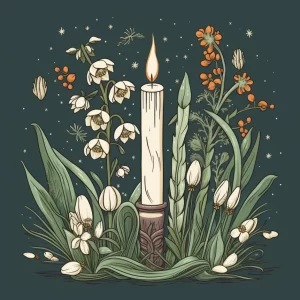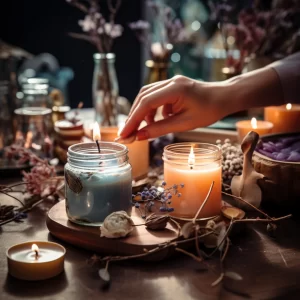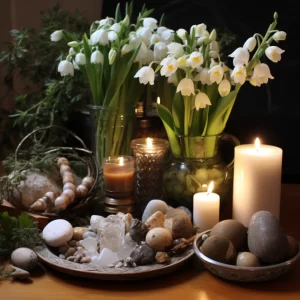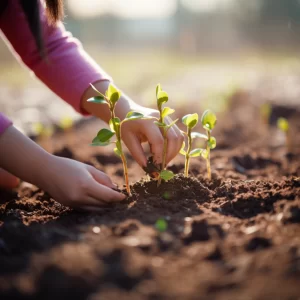
As the wheel of the year turns toward Imbolc, the time is ripe for engaging in creative Imbolc activities that honor the festival’s essence. Crafting is not just a way to celebrate; it’s a meditative practice that connects us to Imbolc’s themes of renewal and rebirth. Let’s explore some hand-crafted Imbolc traditions that will add warmth and intention to your celebration.

Brigid dolls, also known as Brídeógs, are a quintessential part of Imbolc and serve as a representation of the goddess Brigid. These dolls are traditionally made from corn or wheat sheaves and dressed in white fabric. Here’s how you can craft your own:
1. Gather natural materials such as corn husks, straw, or wheat.
2. Soak the materials in water to make them pliable.
3. Bind the materials together to form a simple doll shape.
4. Adorn your Brigid doll with ribbons or fabric, usually in white to symbolize purity.
Placing your Brigid doll in a “Brigid’s Bed” can be a ritualistic way of invoking the goddess’s energy into your home, ensuring her blessings of fertility and protection.
Candle-making is a fitting craft for this fire festival. Imbolc candle rituals are central to the celebration, symbolizing the return of light. You can create your own candles to light during your Imbolc rituals:
1. Choose your wax—soy, beeswax, or candelilla are popular options.
2. Melt the wax in a double boiler, monitoring the temperature closely.
3. Add color or fragrance oils if desired, aligning with Imbolc’s magical correspondences. Note here that I don’t recommend using your expensive essential oils here as it vaporizes too quickly and leaving little to no smell. Fragrance oils will really work better for candles.
4. Secure the wick in your chosen mold or container.
5. Pour the wax, allowing it to set before trimming the wick.
6. Allow your candle to “cure” for a couple days before first use.
Handmade candles not only bring personalized energy to the festivities but also serve as powerful Imbolc decorations.

Crafting a Brigid’s cross from reeds or straw is a profound way to invite protection and blessings into your home.
In the Southwest desert, particularly in an area like Phoenix, AZ, where traditional reed or straw may not be readily available, you can look to native desert plants for crafting materials. For making a Brigid’s Cross, which traditionally uses rushes, a suitable desert plant replacement could be Beargrass (Nolina microcarpa). Beargrass has long, flexible leaves that can be used similarly to rushes or straw when dried.

Here’s a simple guide on how to prepare Beargrass for crafting a Brigid’s Cross:
An altar acts as a focal point for your Imbolc celebrations. It’s a physical manifestation of your intentions and a sacred space for Imbolc spells and meditations. To create your Imbolc altar setup, consider incorporating the following:
– Elements of nature: Evergreens, stones, or flowers like snowdrops, which are among the first blooms of the year.
– Symbols of Brigid: Brigid’s crosses, Brigid dolls, or representations of her sacred flame.
– Candles: White candles are standard, signifying purity and the return of light.
– Seasonal Offering: A bowl of milk and honey to honor the fertility of the earth.
When setting up your altar, it is important to do so with intention and reverence. Your altar will become the spiritual heart of your Imbolc celebration.
These Imbolc crafts not only pay homage to the festival’s traditions but also bring a personal touch to your observance. Crafting can be a solace, a ritual, and a way to express creativity and spirituality.

Whether you’re making a Brigid doll to safeguard your hearth, pouring candles to light up the dark winter evenings, or setting up an altar imbued with symbolism, these activities are pathways to a deeper connection with the season. And as the festival is inherently communal, consider sharing these Imbolc crafting experiences with loved ones to weave tighter bonds and foster collective joy.
As Imbolc signifies the awakening of the land, planting seeds or bulbs is a symbolic act of participation in nature’s cycle. This act is akin to growing an herbal tea garden, where each plant nurtured represents a step towards a more harmonious and self-sustaining lifestyle. It’s also an opportunity to practice Imbolc rituals rooted in earth’s fertility. Consider:
– Choosing seasonal seeds or bulbs that resonate with Imbolc, such as snowdrops or crocuses, known for their early bloom.
– Engaging in a meditative seed planting ritual. With each seed, set an intention for personal growth in harmony with nature’s own burgeoning life.
– Incorporating biodegradable seed paper into your Imbolc crafts, sowing them afterward as a sustainable way to connect your crafting to the land.
Planting is more than putting seeds in the soil; it’s a commitment to nurture, witness, and partake in life’s unfolding.

– Top 10 Cozy Games Engage in cozy, creative activities that complement your crafting.
– Nature’s Whispers Integrate messages from nature into your crafts.
– Cottagecore Fashion Pieces Draw inspiration from fashion to influence your crafting aesthetics.